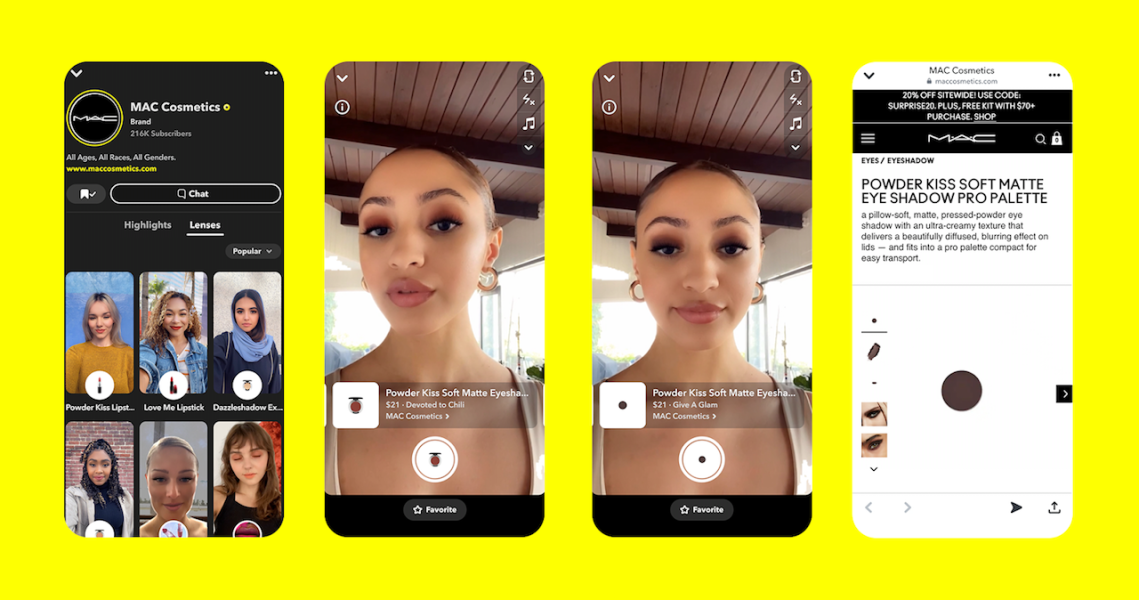Estée Lauder Companies is leaning on Snapchat’s new social AR shopping capabilities.
On May 20, MAC became the first brand in the ELC portfolio to debut a shoppable Snapchat AR try-on lens. Using technology developed through Snapchat’s partnership with Perfect Corp., MAC is offering four different lenses that present a total of 20 lip and eye products. Users can scroll through and test the different shades of each product and then click the link in the lens to purchase on MAC’s DTC site. ELC brands Too Faced, Bobbi Brown and Smashbox will debut on Snapchat with their own shoppable technology over the next few months.
“One thing that we saw during Covid is that there was a huge shift in where consumers spent their time, and [their] consumption of social media made it really important that we go and be where they are,” said Salima Popatia, svp of global consumer acquisition and retention for Estée Lauder Companies’ online division.
MAC’s new foray on Snapchat is the first time ELC has adopted the platform’s shoppable lenses. In December 2020, L’Oréal-owned NYX Cosmetics launched an AR try-on and virtual shopping experience on Snapchat.
The purpose of Snapchat’s new partnership with Perfect Corp. is to reach the “hundreds of brands” that Perfect Corp. has teamed up with “to build thousands of their SKUs in AR,” said Carolina Arguelles, Snapchat’s global product lead in augmented reality. “[We want to] be able to just make it as simple as pushing a button to get those same experiences on Snapchat.” She added that the pandemic has proven to be an “accelerant” for beauty brand adoption.
“By incorporating this technology through social platforms, brands can meet customers where they are and provide fun and engaging shopping experiences,” said Perfect Corp. CEO Alice Chang via email. “Through our Snapchat partnership, brands are able to seamlessly extend their experiences to the Snap community without additional resources, as well as reach one of the most valuable consumer groups: Gen Z.”
Ad position: web_incontent_pos1
MAC Cosmetics also features AR try-on on both its DTC site and in-store. In the past fiscal year, ELC’s entire portfolio has seen site AR try-on features used 6.2 million times with 150 million total engagements. In North America, customers using AR try-on spend an average of 13 minutes on-site, or 3.5 times more time than the average user, said Popatia. Of these users, 80% are accessing the tool on mobile.
AR try-on technology “has improved drastically” over the past four years, said Popatia, who said the ELC team runs tests comparing photos wearing the actual product with the AR. “When you try it on now, it’s come so far. It’s amazing. You can’t even tell the difference.”
The benefit of launching the feature on Snapchat is “bringing together the technology of the augmented reality lenses [and the] instant gratification of actually checking out or shopping and buying,” said Popatia.
Virtual try-on has also been connected to higher online sales. Users of ELC brands’ site virtual try-on tool have a 1.5-times higher conversion rate than other site visitors. Lipstick is an especially big draw for AR try-on: Over 10% of site visitors who click on ELC brands’ lip sections use the AR try-on feature on-site.
Shopping is also a benefit when it comes to social media AR try-on, according to Snapchat.
Ad position: web_incontent_pos2
“This Gen Z-young millennial generation grew up in the digital era; they grew up seeing something and being able to click it. They want to be able to take action,” said Arguelles.
Brands have increasingly turned to virtual try-on during the pandemic, as visiting stores and testing products became a no-go.
“The pandemic certainly pushed retail into a digital-first format, which emphasized the growing importance of e-commerce,” said Chang.
Both platforms and beauty companies are betting on the power of shoppable AR try-on in the long run, even as U.S. Covid-19 cases decline and shoppers head back into stores. A Deloitte study commissioned by Snapchat said that 94% of people are expecting to use AR for shopping as much or more in 2022, compared to 2021.
“I don’t think it’ll go away,” said Popatia, of shoppable AR try-on. She noted that MAC began developing AR try-on technology pre-pandemic to solve the pain point of presenting customers with dozens of lip colors to try on in one sitting. “It gives more value to media; it allows us to ensure that the surprise and delight can be delivered end-to-end to the consumer.”




